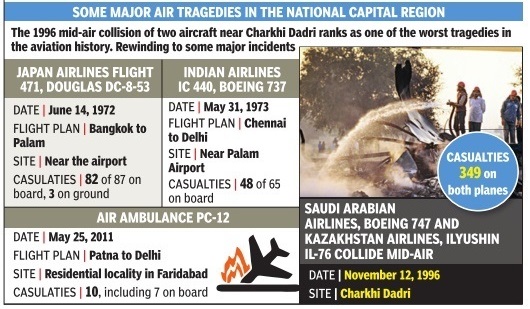Civil Aviation, India/ 1
This is a collection of articles archived for the excellence of their content. |

Contents |
Compensation
Compensation for delays, accidents
Mar 19 2015
Flyers set for higher payoffs from airlines
Accidents, delays to cost carriers more
The Narendra Modi government has enhanced the compensation that airlines must pay passengers in case of lost baggage or suffering an injury while travelling with them. If a person dies or suffers bodily injury in an air crash or some other aviation-related accident, the compensation payabale to the family is now Rs 90 lakh, up from Rs 75 lakh earlier.
In case of inordinate flight delays, the compensation could now be as high as Rs 3.5 lakh, up from Rs 3 lakh earlier. The maximum compensation for lost baggage has now been upped to about Rs 84,000 from Rs 74,000 earlier.
The enhanced compensa tion comes with the Cabinet on Tuesday amending the Air Carriage Act that deals with issues like damages to be paid for flight delays, loss of baggage and accidental death. Indian carriers will now pay as their international counterparts, in line with the 1999 Montreal Convention that governs airline liability and compensation.
These compensations are based on something called special drawing rights (SDR), with each SDR worth $1.2.
In India, SDRs are converted into Indian rupees depending on the exchange rate at the time of payment. Damage in case of death or bodily injury for each person has been upped from a lakh SDR to 1,13,100 SDR. The liability in case of destruction, loss or delay of cargo has been raised from 17 SDR (Rs 1,265) to 19 SDR (Rs 1,400).
The change came as International Civil Aviation Organisation (ICAO) calculated that inflation had risen by over 10% -the trigger for a recalculation. In India, the change came with the Cabinet clearing an amendment to the Carriage by Air Act by inserting a new provision enabling the government to revise the limits of liability as and when the revised limits are notified by the ICAO. India had signed the Montreal Convention in May 2009. Also, the Convention stipulates that the compensation figures must be revised every five years.
Photography
“Air side“ photography
Saurabh Sinha DGCA bars clicking pics near aircraft Sep 15 2016 : The Times of India (Delhi)
Flyers will no longer be allowed to take pictures or selfies while boarding or alighting from aircraft. The Directorate General of Civil Aviation has reinforced restrictions on “air side“ photography by passengers in a new rule issued primarily to prohibit pilots from taking selfies in cockpits of airborne planes as the regulator has found the latter to be a major distraction that could affect safety .
A DGCA air safety circular issued on August 29 has asked airlines to ensure that “passengers do not indulge into photography while embarkingdisembarking from aircraft.“ Also, passengers will no longer be able to request crew to let them in the cockpit to click a quick selfie while disembarking. In fact, photography inside cockpit has been banned for crew also in all phases of flight and not just while flying.
Security of flying aircraft
Bay of Bengal flights gets safer
The Times of India Jan 11 2016
Chennai
TIMES NEWS NETWORK
Flying over Chennai airspace has become safer for international flights as air traffic controllers can now track them better over the Bay of Bengal.
In a bid to enhance safety and monitoring of planes better, Airports Authority of India (AAI) has bifurcated the oceanic airspace, spread over 4 lakh square nautical miles till the Andaman and Nicobar Islands, into west and east regions.
The airspace is crucial for global air connectivity because 400 planes cruise along 14 international routes connecting Europe to Australia and the Far East everyday , over an expansive water body where tracking planes is difficult. This traffic is in addition to the domestic traffic from Chennai and Kolkata to Port Blair. Now, two dedicated teams of air traffic controllers will monitor planes flying in their respective regions so that they will not miss any flights in the airspace that is traffic-intense yet difficult to monitor because radar coverage is not efficient over such a vast area.The system will help overcome blind spots where air traffic controllers will not get signals showing movement o planes on their monitors.
Chennai has the largest airspace spread over the ocean where flights are cur rently monitored using voice communication with very high frequency (VHF) and high frequency telephony controller-pilot datalink, sat ellite phones and satellite based automatic dependent surveillance broadcast used as a backup for radar.
“The airspace has been made into two sectors based on traffic density and workload of controllers, traffic density and the number of points where air routes intersect. This will be implemented in three phases on trial and is expected to help airlines fly at their optimum level and save fuel and time,“ said a senior AAI official.
AAI board member for ANS A K Dutta inaugurated the facility on Saturday and said several such system were being implemented to help airlines cut down on fuel, operational cost and emission. AAI also introduced SMode operation to allow air traffic controllers to identify a plane as soon as they see a blip on their screens based on a code set by the crew.
